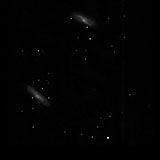
| MESSIER 66 |
|---|
RA: |
11h 20m 12s |
|
DEC: |
+12° 59' 00'' |
|
Type: |
Spiral galaxy |
|
NGC: |
3627 |
|
Magnitude: |
8.90 |
|
Surface brightness : |
12.70 |
|
Apparent dimensions : |
9.1'x4.1' |
|
Distance: |
35,000,000 ly |
|
Discovered 1780 by Charles Messier. M66, together with its neighbors M65 and NGC 3628, forms a most conspicuous triplet of galaxies, the Leo Triplett or M66 group, located at a distance of about 35 million light years. M66 is considerably larger than its neighbor, M65, and has a well developed but not well defined central bulge, and is therefore classified Sb. Obviously its spiral arms are deformed, probably because of the encounters with its neighbors. They seem to be distorted and displaced above the plane of the galaxy. Note how one of the spiral arms seems to pass over the left side of the central bulge. Much dust is visible here, as well as a few pink nebulae, signs of star formation, near the end of one of the arms. Together with its neighbor M65, M66 has been discovered by Charles Messier, who cataloged it on March 1, 1780, remarks that he missed these two objects in 1773, when a comet passed between them on November 1 to 2, 1773, probably because of the light of the comet. |
||
Other sketches |
|||||
 |
 |
||||
M66 together with M65 |
M66 alone |
||||
VEDRAN VRHOVAC© 2006.-2007. |
